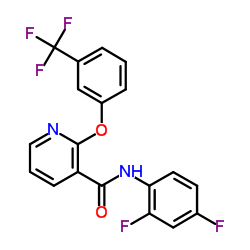吡氟草胺

吡氟草胺结构式

|
常用名 | 吡氟草胺 | 英文名 | diflufenican |
|---|---|---|---|---|
| CAS号 | 83164-33-4 | 分子量 | 394.295 | |
| 密度 | 1.4±0.1 g/cm3 | 沸点 | 376.2±42.0 °C at 760 mmHg | |
| 分子式 | C19H11F5N2O2 | 熔点 | 110°C | |
| MSDS | 中文版 美版 | 闪点 | 181.3±27.9 °C |
|
Multiresidue method for the determination of 13 pesticides in three environmental matrices: water, sediments and fish muscle.
Talanta 85(3) , 1500-7, (2011) Pesticides residues in aquatic ecosystems are an environmental concern which requires efficient analytical methods. In this study, we proposed a generic method for the quantification of 13 pesticides (azoxystrobin, clomazone, diflufenican, dimethachlor, carbe... |
|
|
Single drop microextraction and gas chromatography-mass spectrometry for the determination of diflufenican, mepanipyrim, fipronil, and pretilachlor in water samples.
Environ. Monit. Assess. 185(12) , 10225-33, (2013) An analytical method for the determination of diflufenican, mepanipyrim, pretilachlor, and fipronil in water samples was developed using single drop microextraction in the direct immersion mode and gas chromatography-mass spectrometry. A factorial fractionate... |
|
|
Rainfastness and adsorption of herbicides on hard surfaces.
Pest Manag. Sci. 61(8) , 793-8, (2005) Herbicides are still used to control weeds on hard surfaces, including municipal, private and industrial sites. Used under unfavourable conditions, especially when rain occurs shortly after application, herbicides may run off to surface waters. Such losses of... |
|
|
Spatial variation in the degradation rate of the pesticides isoproturon, azoxystrobin and diflufenican in soil and its relationship with chemical and microbial properties.
Environ. Pollut. 139(2) , 279-87, (2006) The extent of within field variability in the degradation rate of the pesticides isoproturon, azoxystrobin and diflufenican, and the role of intrinsic soil factors and technical errors in contributing to the variability, was investigated in sites on sandy-loa... |
|
|
Evolution of soil biological properties after addition of glyphosate, diflufenican and glyphosate+diflufenican herbicides.
Chemosphere 76(3) , 365-73, (2009) The aim of this paper was to study in laboratory the degradation and the effects on biological properties in two soils after the addition of glyphosate, diflufenican and glyphosate+diflufenican. One hundred grams of sieved soil (<2mm) were mixed with (i) 13mL... |
|
|
Use of metabolic control analysis to give quantitative information on control of lipid biosynthesis in the important oil crop, Elaeis guineensis (oilpalm).
New Phytol. 184(2) , 330-9, (2009) * Oil crops are a very important commodity. Although many genes and enzymes involved in lipid accumulation have been identified, much less is known of regulation of the overall process. To address the latter we have applied metabolic control analysis to lipid... |
|
|
Soil surface structure effect on isoproturon and diflufenican loss in runoff.
J. Environ. Qual. 30(6) , 2113-9, (2001) Because soil surface structure has a considerable influence on infiltration rate, the sealing process is postulated to have a significant effect on herbicide loss through runoff. We evaluated the effect of degraded soil surface structures on herbicide loss in... |
|
|
Aquatic toxicity tests with substances that are poorly soluble in water and consequences for environmental risk assessment.
Environ. Toxicol. Chem. 31(7) , 1662-9, (2012) Aquatic toxicity tests with substances that are poorly soluble in water have been conducted using different methods, and estimates of toxicity have varied accordingly. The present study illustrates differences in toxicity values resulting from variation in te... |
|
|
Analytical methods for the determination of isoproturon and diflufenican residues in runoff and soil.
Bull. Environ. Contam. Toxicol. 55(6) , 802-9, (1995)
|
|
|
The effect of diflufenican on lipid metabolism in plants.
Biochem. Soc. Trans. 19(3) , 320S, (1991)
|